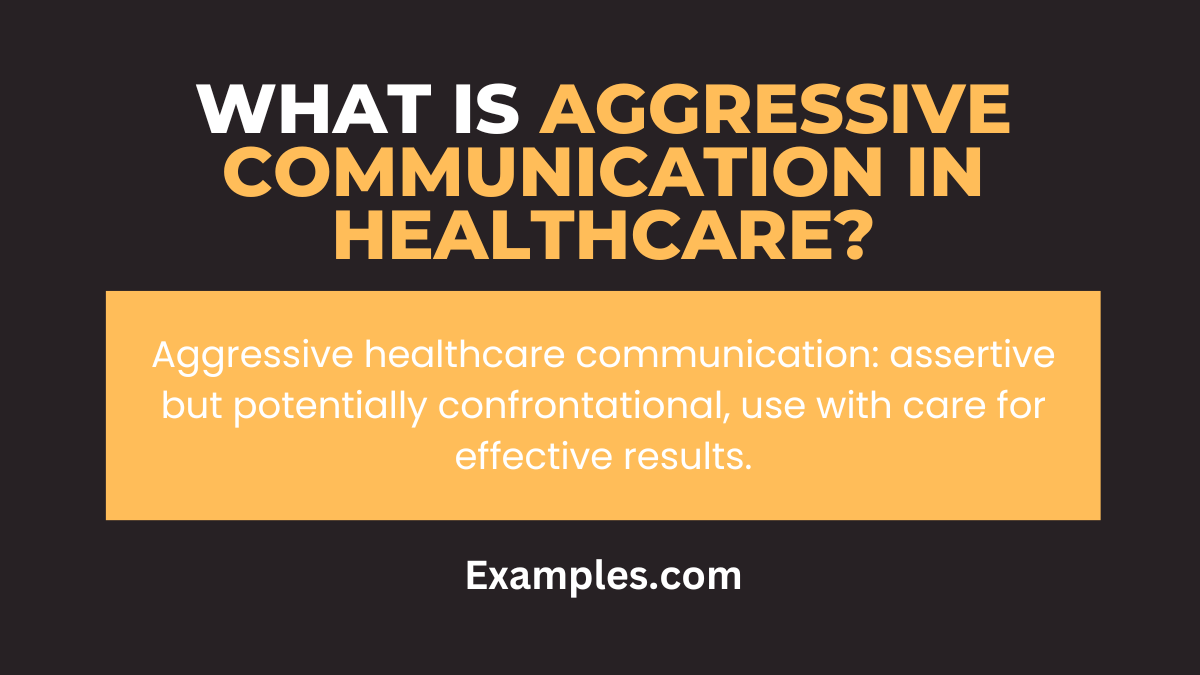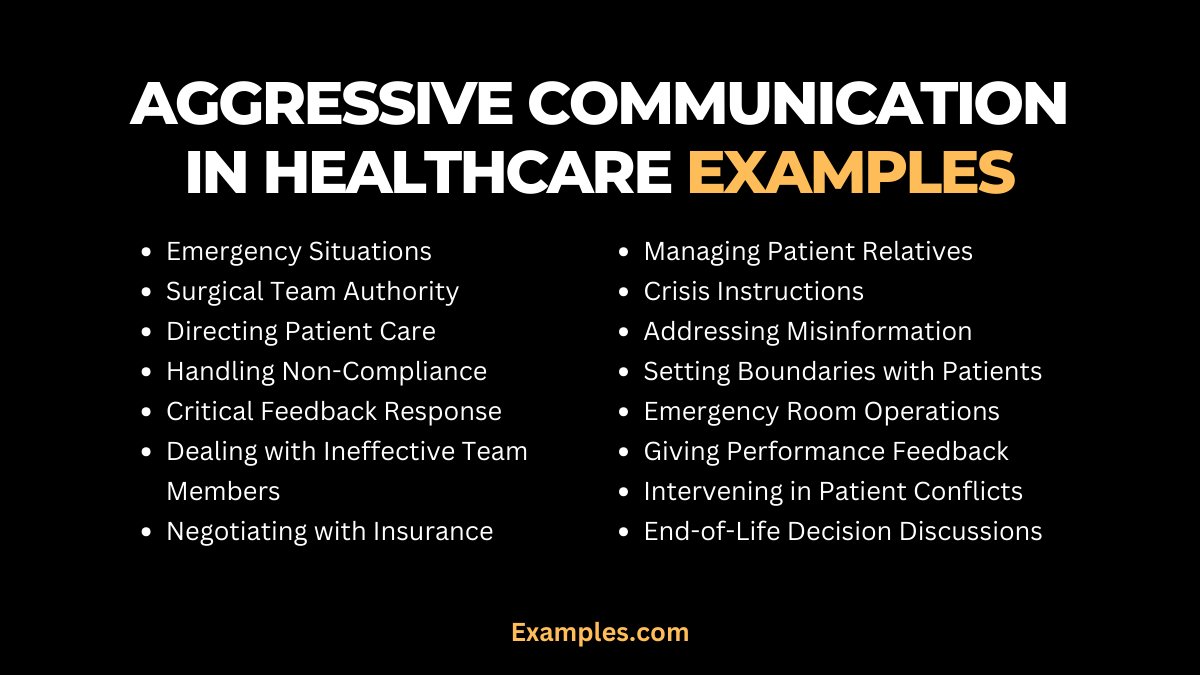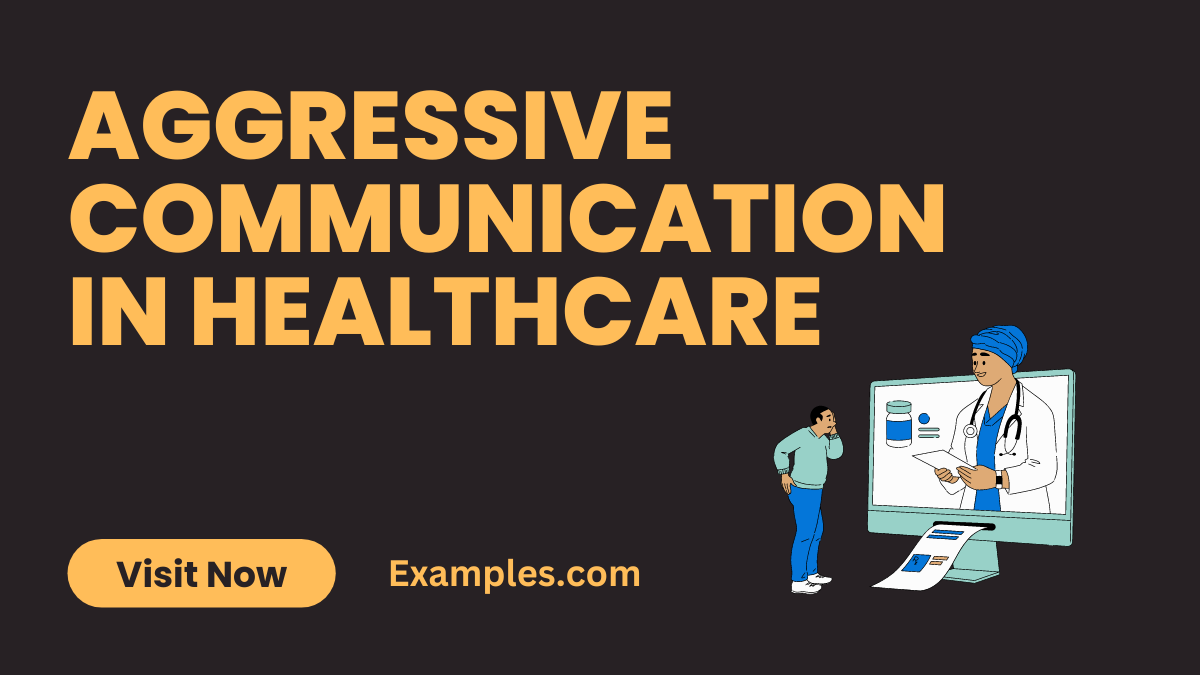15+ Aggressive Communication in Healthcare Examples
In the dynamic realm of healthcare, communication plays a pivotal role. Aggressive communication, often misunderstood, can be a double-edged sword. This guide delves deep into the nuanced world of aggressive communication in healthcare, offering vivid examples and critical insights. It juxtaposes aggressive styles with passive approaches, highlighting the delicate balance required for effective and empathetic patient care. This comprehensive exploration is a must-read for healthcare professionals seeking to refine their communication skills and enhance patient interactions.
What is Aggressive Communication in Healthcare?

Aggressive communication in healthcare is a communication style characterized by assertiveness that often borders on forcefulness. Unlike passive communication, which tends to be submissive, aggressive communication is direct and can sometimes be perceived as confrontational. In healthcare settings, this form of communication is used to assert opinions, needs, or rights in a straightforward manner, often with little regard for the views or feelings of others. While it can be effective in certain urgent or high-stakes situations, it’s important to balance it with empathy and understanding to avoid negative impacts on patient care and team dynamics.
15 Aggressive Communication in Healthcare Examples

- Demanding Immediate Action in Emergency Situations: In urgent scenarios, healthcare professionals may use aggressive communication to expedite care. Example: “I need this test done now! Every second counts.”
- Asserting Authority in Surgical Teams: Surgeons often use assertive language to maintain control in the operating room. Example: “I’m in charge here; follow my instructions precisely.”
- Directing Patient Care with Firmness: Nurses sometimes need to be forceful to ensure patient compliance. Example: “You must take your medication now, it’s not negotiable.”
- Handling Non-Compliant Patients: Aggressive communication can be used to manage difficult or uncooperative patients. Example: “You have to follow these procedures, there’s no other option.”
- Dealing with Critical Patient Feedback: Responding to complaints or negative feedback often requires a firm stance. Example: “Your concerns are heard, but this is the best course of action.”
- Confronting Ineffective Team Members: Addressing underperformance or errors in a direct manner. Example: “Your work has been unsatisfactory, and this needs to change immediately.”
- Negotiating with Insurance Companies: Often involves assertive dialogue to advocate for patient needs. Example: “We require this treatment approved; it’s critical for the patient.”
- Instructing During a Crisis: Clarity and assertiveness are vital in high-pressure situations. Example: “Everyone needs to stay calm and follow my lead now.”
- Managing Patient Relatives in Stressful Situations: Sometimes requires a firm approach to maintain order. Example: “You must wait outside; we’re doing everything we can.”
- Addressing Misinformation with Patients: Correcting false beliefs or misunderstandings decisively. Example: “That’s not correct; let me explain the facts.”
- Setting Boundaries with Demanding Patients: Essential for maintaining professional limits. Example: “I understand your concern, but that request isn’t possible.”
- Directing Emergency Room Operations: Requires a commanding tone to manage chaos. Example: “I need this area cleared now, move quickly!”
- Giving Critical Performance Feedback: Directly addressing issues in staff performance. Example: “Your approach needs immediate improvement for better patient care.”
- Intervening in Patient Conflicts: Healthcare professionals may need to be firm to resolve disputes. Example: “Stop arguing; we need to focus on treatment.”
- Discussing End-of-Life Decisions: Necessitates a balance of assertiveness and sensitivity. Example: “We need to make some difficult decisions about care options.”
Benefits of Aggressive Communication in Healthcare

- Enhanced Decision-Making Speed: Aggressive communication in healthcare settings often leads to quicker decision-making. In emergencies, direct and assertive instructions from healthcare professionals can significantly reduce response times, leading to more efficient patient care.
- Clear and Unambiguous Instructions: This communication style ensures that instructions are conveyed clearly and unambiguously. It minimizes the risk of misunderstandings and errors, particularly crucial in high-stakes medical procedures.
- Effective in Crisis Management: During crisis situations, such as code blues or mass casualty incidents, aggressive communication can be vital. It helps in maintaining order, ensuring that everyone in the healthcare team knows their role and responds promptly.
- Asserts Authority and Leadership: In healthcare, particularly in surgical or critical care units, establishing authority is essential. Aggressive communication can help in asserting leadership, ensuring that protocols are followed and that there’s no confusion in roles and responsibilities.
- Improved Compliance from Patients: In some cases, especially with non-compliant or difficult patients, a more direct approach might be needed to ensure that they follow medical advice or treatment plans. Aggressive communication, when used appropriately, can aid in achieving better compliance from patients.
How Does Aggressive Communication Impact Patient Care?
- Quick Response in Emergencies: Aggressive communication can lead to faster responses in emergency situations. Direct and clear instructions ensure that healthcare professionals act swiftly, which can be crucial for patient survival and recovery.
- Potential for Misinterpretation: While clarity is a benefit, there’s also a risk that such communication can be misinterpreted by patients as rudeness or lack of empathy. This can affect the patient’s emotional well-being and their perception of care quality.
- Efficient Team Coordination: In a fast-paced healthcare environment, aggressive communication can enhance team coordination. It ensures that everyone understands their roles and responsibilities clearly, leading to more organized and effective patient care.
- Impact on Patient Trust and Comfort: Patients may feel intimidated or uncomfortable with aggressive communication, which can lead to a lack of trust in their healthcare providers. This discomfort can adversely affect their overall care experience and willingness to share vital health information.
- Stress and Anxiety in Patients and Staff: Continuous aggressive communication can create a stressful environment for both patients and healthcare staff. For patients, this can lead to increased anxiety, which might negatively impact their recovery process. For staff, it can contribute to burnout and job dissatisfaction.
What Strategies Can Be Used to Manage Aggressive Communication in Healthcare?

- Training and Awareness: Implementing regular training programs focusing on communication skills can help healthcare professionals understand when and how to use aggressive communication effectively. Workshops on assertive communication can provide tools to express assertiveness without crossing into aggression.
- Emotional Intelligence Development: Cultivating emotional intelligence among healthcare staff enables them to recognize and regulate emotions, a key skill in managing aggressive communication. This involves understanding one’s own communication style and its impact on others.
- Feedback Mechanisms: Establishing a system for feedback allows healthcare workers to receive constructive criticism regarding their communication methods. Peer reviews and patient feedback can highlight instances of effective communication or areas needing improvement.
- Balancing with Empathy: Training in therapeutic communication can help professionals balance assertiveness with empathy. This approach ensures that patient care is not compromised and that the patient feels heard and respected.
- Conflict Resolution Training: Equipping staff with conflict resolution skills can help in de-escalating situations where aggressive communication may become counterproductive. Understanding and practicing nonviolent communication can aid in resolving disagreements amicably and constructively.
Aggressive communication in healthcare is a nuanced tool that, when used judiciously, can enhance patient care and team efficiency. However, balancing it with empathy and understanding is crucial. By incorporating strategies to manage this communication style, healthcare professionals can ensure effective patient care and foster a positive, collaborative environment. This guide offers valuable insights and examples for navigating these complex dynamics.
15+ Aggressive Communication in Healthcare Examples

In the dynamic realm of healthcare, communication plays a pivotal role. Aggressive communication, often misunderstood, can be a double-edged sword. This guide delves deep into the nuanced world of aggressive communication in healthcare, offering vivid examples and critical insights. It juxtaposes aggressive styles with passive approaches, highlighting the delicate balance required for effective and empathetic patient care. This comprehensive exploration is a must-read for healthcare professionals seeking to refine their communication skills and enhance patient interactions.
What is Aggressive Communication in Healthcare?

Aggressive communication in healthcare is a communication style characterized by assertiveness that often borders on forcefulness. Unlike passive communication, which tends to be submissive, aggressive communication is direct and can sometimes be perceived as confrontational. In healthcare settings, this form of communication is used to assert opinions, needs, or rights in a straightforward manner, often with little regard for the views or feelings of others. While it can be effective in certain urgent or high-stakes situations, it’s important to balance it with empathy and understanding to avoid negative impacts on patient care and team dynamics.
15 Aggressive Communication in Healthcare Examples

Demanding Immediate Action in Emergency Situations: In urgent scenarios, healthcare professionals may use aggressive communication to expedite care. Example: “I need this test done now! Every second counts.”
Asserting Authority in Surgical Teams: Surgeons often use assertive language to maintain control in the operating room. Example: “I’m in charge here; follow my instructions precisely.”
Directing Patient Care with Firmness: Nurses sometimes need to be forceful to ensure patient compliance. Example: “You must take your medication now, it’s not negotiable.”
Handling Non-Compliant Patients: Aggressive communication can be used to manage difficult or uncooperative patients. Example: “You have to follow these procedures, there’s no other option.”
Dealing with Critical Patient Feedback: Responding to complaints or negative feedback often requires a firm stance. Example: “Your concerns are heard, but this is the best course of action.”
Confronting Ineffective Team Members: Addressing underperformance or errors in a direct manner. Example: “Your work has been unsatisfactory, and this needs to change immediately.”
Negotiating with Insurance Companies: Often involves assertive dialogue to advocate for patient needs. Example: “We require this treatment approved; it’s critical for the patient.”
Instructing During a Crisis: Clarity and assertiveness are vital in high-pressure situations. Example: “Everyone needs to stay calm and follow my lead now.”
Managing Patient Relatives in Stressful Situations: Sometimes requires a firm approach to maintain order. Example: “You must wait outside; we’re doing everything we can.”
Addressing Misinformation with Patients: Correcting false beliefs or misunderstandings decisively. Example: “That’s not correct; let me explain the facts.”
Setting Boundaries with Demanding Patients: Essential for maintaining professional limits. Example: “I understand your concern, but that request isn’t possible.”
Directing Emergency Room Operations: Requires a commanding tone to manage chaos. Example: “I need this area cleared now, move quickly!”
Giving Critical Performance Feedback: Directly addressing issues in staff performance. Example: “Your approach needs immediate improvement for better patient care.”
Intervening in Patient Conflicts: Healthcare professionals may need to be firm to resolve disputes. Example: “Stop arguing; we need to focus on treatment.”
Discussing End-of-Life Decisions: Necessitates a balance of assertiveness and sensitivity. Example: “We need to make some difficult decisions about care options.”
Benefits of Aggressive Communication in Healthcare

Enhanced Decision-Making Speed: Aggressive communication in healthcare settings often leads to quicker decision-making. In emergencies, direct and assertive instructions from healthcare professionals can significantly reduce response times, leading to more efficient patient care.
Clear and Unambiguous Instructions: This communication style ensures that instructions are conveyed clearly and unambiguously. It minimizes the risk of misunderstandings and errors, particularly crucial in high-stakes medical procedures.
Effective in Crisis Management: During crisis situations, such as code blues or mass casualty incidents, aggressive communication can be vital. It helps in maintaining order, ensuring that everyone in the healthcare team knows their role and responds promptly.
Asserts Authority and Leadership: In healthcare, particularly in surgical or critical care units, establishing authority is essential. Aggressive communication can help in asserting leadership, ensuring that protocols are followed and that there’s no confusion in roles and responsibilities.
Improved Compliance from Patients: In some cases, especially with non-compliant or difficult patients, a more direct approach might be needed to ensure that they follow medical advice or treatment plans. Aggressive communication, when used appropriately, can aid in achieving better compliance from patients.
How Does Aggressive Communication Impact Patient Care?
Quick Response in Emergencies: Aggressive communication can lead to faster responses in emergency situations. Direct and clear instructions ensure that healthcare professionals act swiftly, which can be crucial for patient survival and recovery.
Potential for Misinterpretation: While clarity is a benefit, there’s also a risk that such communication can be misinterpreted by patients as rudeness or lack of empathy. This can affect the patient’s emotional well-being and their perception of care quality.
Efficient Team Coordination: In a fast-paced healthcare environment, aggressive communication can enhance team coordination. It ensures that everyone understands their roles and responsibilities clearly, leading to more organized and effective patient care.
Impact on Patient Trust and Comfort: Patients may feel intimidated or uncomfortable with aggressive communication, which can lead to a lack of trust in their healthcare providers. This discomfort can adversely affect their overall care experience and willingness to share vital health information.
Stress and Anxiety in Patients and Staff: Continuous aggressive communication can create a stressful environment for both patients and healthcare staff. For patients, this can lead to increased anxiety, which might negatively impact their recovery process. For staff, it can contribute to burnout and job dissatisfaction.
What Strategies Can Be Used to Manage Aggressive Communication in Healthcare?

Training and Awareness: Implementing regular training programs focusing on communication skills can help healthcare professionals understand when and how to use aggressive communication effectively. Workshops on assertive communication can provide tools to express assertiveness without crossing into aggression.
Emotional Intelligence Development: Cultivating emotional intelligence among healthcare staff enables them to recognize and regulate emotions, a key skill in managing aggressive communication. This involves understanding one’s own communication style and its impact on others.
Feedback Mechanisms: Establishing a system for feedback allows healthcare workers to receive constructive criticism regarding their communication methods. Peer reviews and patient feedback can highlight instances of effective communication or areas needing improvement.
Balancing with Empathy: Training in therapeutic communication can help professionals balance assertiveness with empathy. This approach ensures that patient care is not compromised and that the patient feels heard and respected.
Conflict Resolution Training: Equipping staff with conflict resolution skills can help in de-escalating situations where aggressive communication may become counterproductive. Understanding and practicing nonviolent communication can aid in resolving disagreements amicably and constructively.
Aggressive communication in healthcare is a nuanced tool that, when used judiciously, can enhance patient care and team efficiency. However, balancing it with empathy and understanding is crucial. By incorporating strategies to manage this communication style, healthcare professionals can ensure effective patient care and foster a positive, collaborative environment. This guide offers valuable insights and examples for navigating these complex dynamics.


